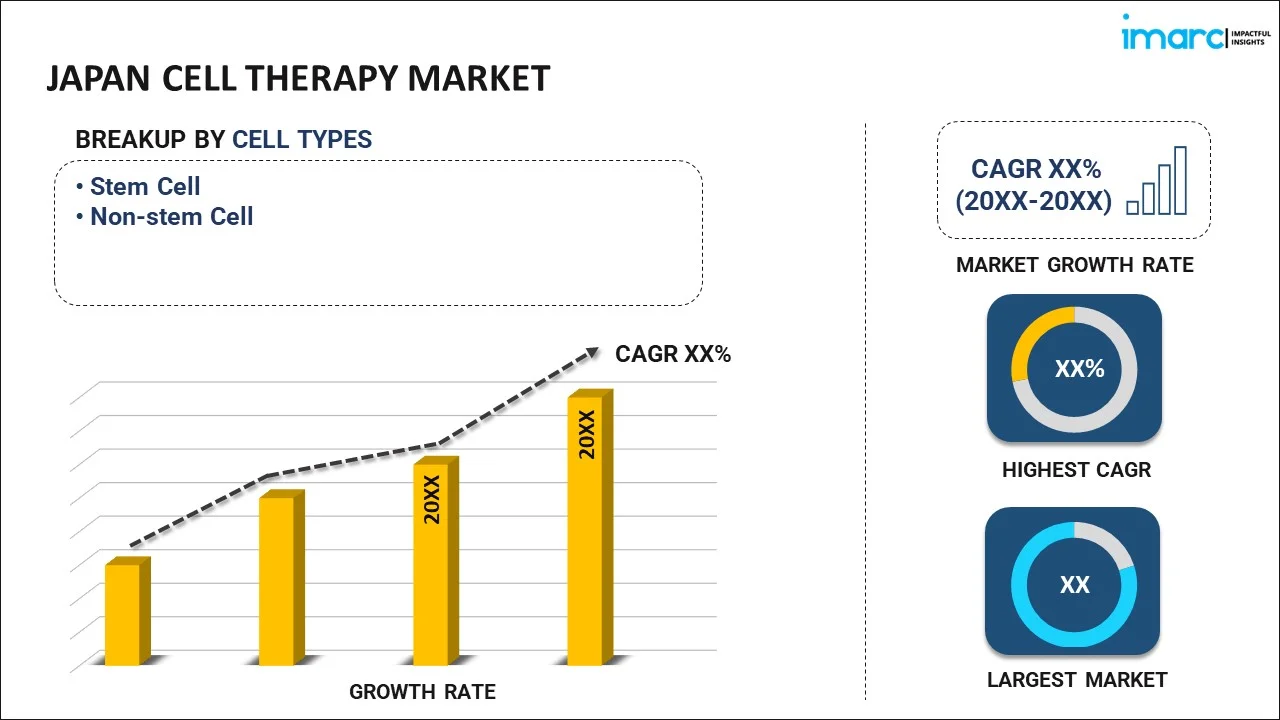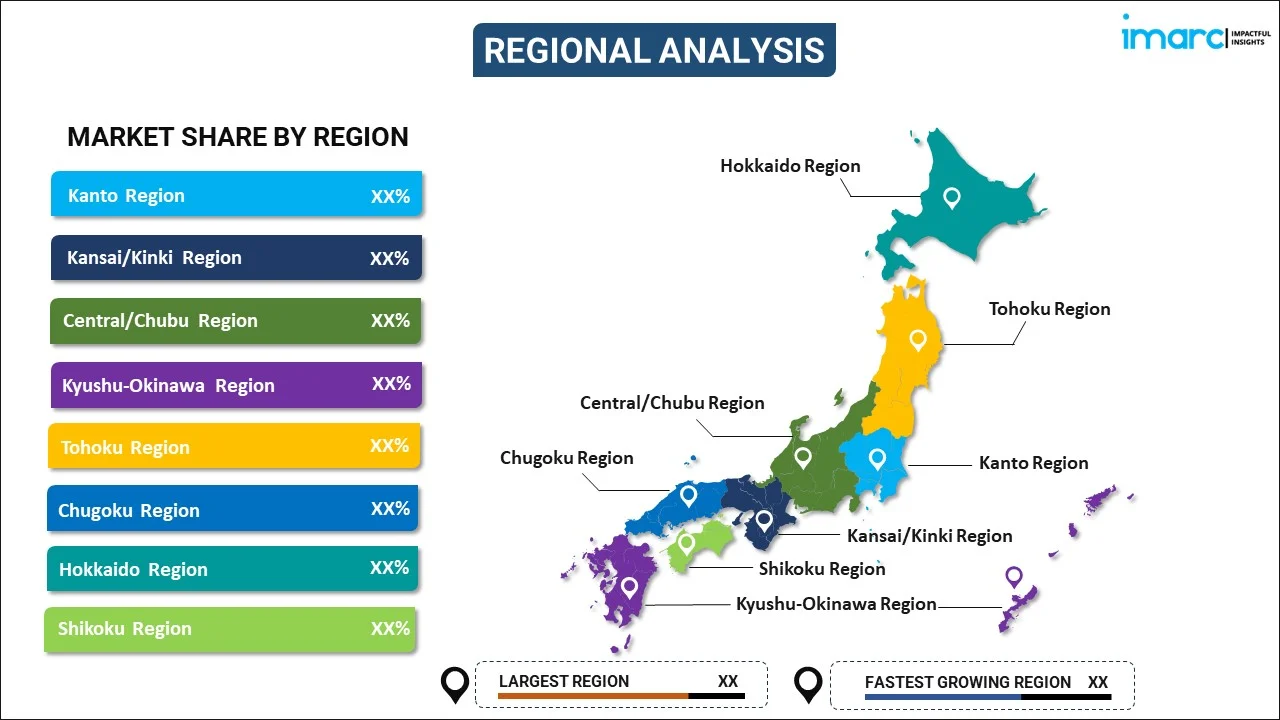
Japan Cell Therapy Market Report by Cell Type (Stem Cell, Non-stem Cell), Therapy Type (Autologous, Allogeneic), Therapeutic Area (Malignancies, Musculoskeletal Disorders, Autoimmune Disorders, Dermatology, and Others), End User (Hospitals and Clinics, Academic and Research Institutes), and Region 2025-2033
Market Overview:
Japan cell therapy market size reached USD 377.0 Million in 2024. Looking forward, IMARC Group expects the market to reach USD 1,763.6 Million by 2033, exhibiting a growth rate (CAGR) of 17.77% during 2025-2033. Some of the factors driving the market include the increasing knowledge among patients, the rising backing from the government, and the widening scope of insurance coverage.
|
Report Attribute
|
Key Statistics
|
|---|---|
|
Base Year
|
2024
|
|
Forecast Years
|
2025-2033
|
|
Historical Years
|
2019-2024
|
|
Market Size in 2024
|
USD 377.0 Million |
|
Market Forecast in 2033
|
USD 1,763.6 Million |
| Market Growth Rate 2025-2033 | 17.77% |
Cell therapy (CT) involves the transfer of human cells to address damage to tissues and cells, offering remedies for various medical conditions. This comprehensive approach includes various types of cells such as hematopoietic stem cells (HSC), skeletal muscle and mesenchymal stem cells, lymphocytes, dendritic cells, and pancreatic islet cells. Its applications go beyond strengthening the immune system for cancer treatment and also encompass the treatment of autoimmune and infectious diseases, urinary issues, joint cartilage damage, spinal cord injuries, compromised immune systems, and neurological disorders. It plays a crucial role in the production of regenerative medicines, facilitating the creation and implementation of innovative treatments aimed at the restoration of tissues and organs and the recovery of functions affected by aging, diseases, or injuries.
Japan Cell Therapy Market Trends:
The Japan cell therapy market is primarily stimulated by the rapid progressions in biotechnology. This development is complemented by a notable increase in research and development endeavors, which are playing a significant role in the market's growth. Additionally, the influx of funding from both governmental sources and private investors is further fueling the research and commercialization of cell therapy. Furthermore, the expansion of clinical trial activities serves to authenticate the effectiveness and safety of cell therapies, thereby accelerating market expansion. The escalating prevalence of chronic and degenerative diseases is creating a demand for advanced treatment options, consequently propelling the market forward. With an aging population, there is a growing necessity for regenerative therapies tailored to age-related conditions, thus fortifying the market. Moreover, the increasing popularity of personalized cell therapies tailored to individual patients is fostering the growth of the market. Regulatory agencies are also providing clearer pathways for the approval of cell therapy, fostering a positive outlook for the market. The competitive landscape is driving innovation and diversification of cell therapy products, while the escalating incidence of rare diseases is further contributing to the market's upward trajectory.
Japan Cell Therapy Market Segmentation:
IMARC Group provides an analysis of the key trends in each segment of the market, along with forecasts at the country level for 2025-2033. Our report has categorized the market based on cell type, therapy type, therapeutic area, and end user.
Cell Type Insights:

- Stem Cell
- Bone Marrow
- Blood
- Umbilical Cord-Derived
- Adipose-Derived Stem Cell
- Others
- Non-stem Cell
The report has provided a detailed breakup and analysis of the market based on the cell type. This includes stem cell (bone marrow, blood, umbilical cord-derived, adipose-derived stem cell, and others) and non-stem cell.
Therapy Type Insights:
- Autologous
- Allogeneic
A detailed breakup and analysis of the market based on the therapy type have also been provided in the report. This includes autologous and allogeneic.
Therapeutic Area Insights:
- Malignancies
- Musculoskeletal Disorders
- Autoimmune Disorders
- Dermatology
- Others
The report has provided a detailed breakup and analysis of the market based on the therapeutic area. This includes malignancies, musculoskeletal disorders, autoimmune disorders, dermatology, and others.
End User Insights:
- Hospitals and Clinics
- Academic and Research Institutes
A detailed breakup and analysis of the market based on the end user have also been provided in the report. This includes hospitals and clinics and academic and research institutes.
Regional Insights:

- Kanto Region
- Kansai/Kinki Region
- Central/ Chubu Region
- Kyushu-Okinawa Region
- Tohoku Region
- Chugoku Region
- Hokkaido Region
- Shikoku Region
The report has also provided a comprehensive analysis of all the major regional markets, which include Kanto Region, Kansai/Kinki Region, Central/ Chubu Region, Kyushu-Okinawa Region, Tohoku Region, Chugoku Region, Hokkaido Region, and Shikoku Region.
Competitive Landscape:
The market research report has also provided a comprehensive analysis of the competitive landscape. Competitive analysis such as market structure, key player positioning, top winning strategies, competitive dashboard, and company evaluation quadrant has been covered in the report. Also, detailed profiles of all major companies have been provided.
Japan Cell Therapy Market Report Coverage:
| Report Features | Details |
|---|---|
| Base Year of the Analysis | 2024 |
| Historical Period | 2019-2024 |
| Forecast Period | 2025-2033 |
| Units | Million USD |
| Scope of the Report | Exploration of Historical Trends and Market Outlook, Industry Catalysts and Challenges, Segment-Wise Historical and Future Market Assessment:
|
| Cell Types Covered |
|
| Therapy Types Covered | Autologous, Allogeneic |
| Therapeutic Areas Covered | Malignancies, Musculoskeletal Disorders, Autoimmune Disorders, Dermatology, Others |
| End Users Covered | Hospitals and Clinics, Academic and Research Institutes |
| Regions Covered | Kanto Region, Kansai/Kinki Region, Central/ Chubu Region, Kyushu-Okinawa Region, Tohoku Region, Chugoku Region, Hokkaido Region, Shikoku Region |
| Customization Scope | 10% Free Customization |
| Post-Sale Analyst Support | 10-12 Weeks |
| Delivery Format | PDF and Excel through Email (We can also provide the editable version of the report in PPT/Word format on special request) |
Key Questions Answered in This Report:
- How has the Japan cell therapy market performed so far and how will it perform in the coming years?
- What has been the impact of COVID-19 on the Japan cell therapy market?
- What is the breakup of the Japan cell therapy market on the basis of cell type?
- What is the breakup of the Japan cell therapy market on the basis of therapy type?
- What is the breakup of the Japan cell therapy market on the basis of therapeutic area?
- What is the breakup of the Japan cell therapy market on the basis of end user?
- What are the various stages in the value chain of the Japan cell therapy market?
- What are the key driving factors and challenges in the Japan cell therapy?
- What is the structure of the Japan cell therapy market and who are the key players?
- What is the degree of competition in the Japan cell therapy market?
Key Benefits for Stakeholders:
- IMARC’s industry report offers a comprehensive quantitative analysis of various market segments, historical and current market trends, market forecasts, and dynamics of the Japan cell therapy market from 2019-2033.
- The research report provides the latest information on the market drivers, challenges, and opportunities in the Japan cell therapy market.
- Porter's five forces analysis assist stakeholders in assessing the impact of new entrants, competitive rivalry, supplier power, buyer power, and the threat of substitution. It helps stakeholders to analyze the level of competition within the Japan cell therapy industry and its attractiveness.
- Competitive landscape allows stakeholders to understand their competitive environment and provides an insight into the current positions of key players in the market.
Need more help?
- Speak to our experienced analysts for insights on the current market scenarios.
- Include additional segments and countries to customize the report as per your requirement.
- Gain an unparalleled competitive advantage in your domain by understanding how to utilize the report and positively impacting your operations and revenue.
- For further assistance, please connect with our analysts.
 Inquire Before Buying
Inquire Before Buying
 Speak to an Analyst
Speak to an Analyst
 Request Brochure
Request Brochure
 Request Customization
Request Customization




.webp)




.webp)












